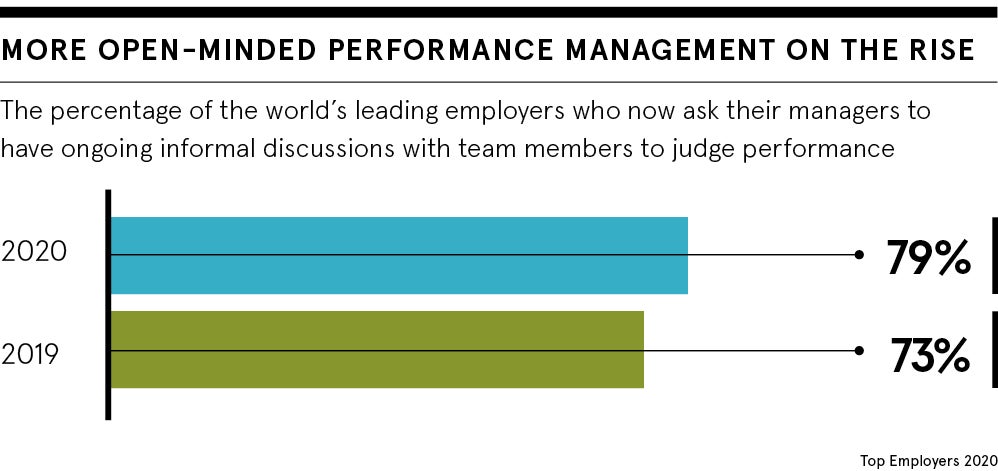
The coronavirus pandemic has accelerated the rate of digital and business transformation, and capitalising on every ounce of employee potential is non-negotiable. The crisis may be a catalyst for restructures and talent challenges, but nurturing the potential of every employee is the key to unlocking the benefits of these extraordinary times.
With so much uncertainty facing people, the coming year is an opportunity to grow employee engagement, ensuring they want to be part of the journey through the pandemic and beyond.
And while traditional views of an organisation’s top talent might exclude vast swathes of employees, there is a surge in thinking that empowering staff to take ownership of their career development can reap rewards for them and the business.
Evidence suggests that “allowing employees agency over their careers can result in more engaged and motivated employees”, leading to positive impacts on levels of performance, says Emma Parry, professor of human resource management and head of the Changing World of Work Group at Cranfield School of Management.
“What is happening in the pandemic is that organisations are learning the importance of open and ongoing communications,” says Parry. “For me this is key to democratising talent development.”
This emphasis on transparent career paths and skills requirements means “identifying leadership potential can become a conversation between employers and employees rather than something done with smoke and mirrors”, she adds.
Democratic approach to talent management
Encouragingly, research shows many employers are promoting more democratic approaches to talent management.
The Top Employers Institute analysed the practices of 1,500 leading employers in attracting, retaining and developing employee potential to drive change in their organisations.
It found that 89 per cent of employers designed leadership development programmes for different roles and levels, with the same percentage focusing on the competencies and behaviours needed.
Organisations are learning the importance of open and ongoing communications… this is key to democratising talent development
Meanwhile, there is a “clear trend towards a more broad-minded approach to career development”, says Phil Sproston, Top Employers Institute UK and Ireland manager, with 97 per cent of organisations consistently expecting managers to promote development of team members.
The results suggest these employers are focusing more on specific traits and attitudes, rather than identifying high-potential employees by looking at certain departments or seniority levels.
Considering skillsets, rather than simply an employee’s ability to do the specific role they were hired for, can be transformational in workforces, especially as businesses adapt to current market conditions.
It is an exciting time to explore these fundamentals of skills and strengths, which can pull out untapped employee potential, rather than using subjective criteria reflecting current leadership.
Traditionally structured hierarchies are not excluded from democratic approaches to maximising employee potential though. Parry points out: “This is not about structure per se, but more about enabling open conversations around talent management decisions.”
This might mean the end of the classic nine-box matrix to identify talent. “Developing a culture of transparency in relation to people’s talent and aspirations allows a more inclusive and effective approach to identifying employee potential,” she explains.

Objectively identifying leadership potential
Dan Lucy, principal research fellow at the Institute for Employment Studies (IES), agrees more rigour is needed in developing employee potential.
“The pandemic has exposed so many inequalities and organisations have to be much more rigorous in identifying talent objectively,” he acknowledges.
Strength-based development plans can lead to 29 per cent increased profits and up to 72 per cent reduced staff churn for organisations, according to a Gallup study.
Allowing employees to identify, develop and use their core strengths fosters accountability and a more democratic approach to talent management.
“As well as understanding what skills employees have, widening access to learning and development adds to the flexibility of the entire workforce, which is really valuable right now,” adds Lucy.
Marketing business MVF topped the Sunday Times Best Companies to Work For 2020 index and its chief people officer Andrea Pattico says ensuring employees can develop their strengths and are aware of opportunities is critical to its success.
“Employee potential is not static so it’s important to keep talking about what is right for the individual, their career and the business over a reasonable period such as 12 months, rather than assume nothing changes over a three to five-year period,” she says.
Investment in learning and development
An individual annual training budget for every employee, yearly cross-department learning festival and advanced academies open to anyone in the business, regardless of department, means MVF is “finding ways to help our people to reach their career goals as well as keeping great people in the business for longer”, says Pattico.
At digital services provider Foundation SP, which led the rankings in the annual 2020 UK’s Best Workplaces for medium-sized businesses, a commitment to empowering employees to drive their own career paths is part of the talent management blueprint.
“We actively encourage employees to strive towards developmental progression and self-fulfilment,” says Foundation SP chief executive Simon Grosse. “Continuous two-way feedback is important, ensuring it is a regular dialogue that is heard and actioned, rather than a one-time event.”
Peer-to-peer mentoring and coaching help to spark innovation, along with “cross-pollination of roles and responsibilities”, an approach Grosse says has led to an uplift in profit in the past 12 months, along with low levels of employee turnover.
For firms that have not previously had a digital-led approach, physical changes to workplaces brought about by the pandemic and multiple lockdowns could have a huge impact on traditional notions of career development, talent management and leadership.
Technology is proving an equaliser through collaborative working practices and internal mobility tools, while the spike in online meetings means opportunities for employees to showcase ideas in ways that may not have existed before.
“Progression might not always be upwards, but there still needs to be a sense of development for employees,” Lucy at IES concludes. “Transparency and support are fundamental to democratising employee potential.”

The coronavirus pandemic has accelerated the rate of digital and business transformation, and capitalising on every ounce of employee potential is non-negotiable. The crisis may be a catalyst for restructures and talent challenges, but nurturing the potential of every employee is the key to unlocking the benefits of these extraordinary times.
With so much uncertainty facing people, the coming year is an opportunity to grow employee engagement, ensuring they want to be part of the journey through the pandemic and beyond.
And while traditional views of an organisation’s top talent might exclude vast swathes of employees, there is a surge in thinking that empowering staff to take ownership of their career development can reap rewards for them and the business.





